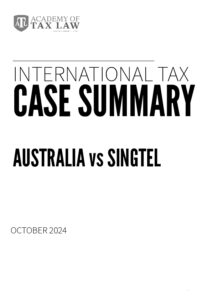Australia vs Singtel: CASE SUMMARY
Home » Case Library »
Australia vs Singtel: CASE SUMMARY
Case Information
- Court: High Court of Australia
- Case No: M28 of 2024
- Applicant: Singapore Telecom Australia Investments Pty Ltd
- Defendant: Commissioner of Taxation
- Judgment Date: 25 October 2024
- Download the FULL JUDGMENT
Judgment Summary
The High Court of Australia deliberated on a significant transfer pricing case between Singapore Telecom Australia Investments Pty Ltd (STAI) and the Commissioner of Taxation, centering on whether a parental guarantee should be implied in assessing the arm’s length nature of intercompany loans. The Commissioner argued that the financial arrangements between STAI and its related parties should consider the implicit financial support provided by the ultimate parent company, SingTel. This imputation would lower the interest rate, affecting STAI’s deductible interest expenses under Australian tax law.
During proceedings, expert testimonies focused on the credit rating adjustments and whether they reflected appropriate arm’s length terms. STAI’s experts, Dr. Chambers and Mr. Chigas, testified that independent financial arrangements would necessitate a higher interest margin, asserting that any adjustments would violate the principle of treating the parties as independent. The Commissioner’s experts, however, contended that the parent-subsidiary relationship justified implicit credit support.
The High Court dismissed the application for special leave to appeal, citing a lack of compelling evidence to refute the findings of the lower courts. Chief Justice Gageler emphasized that the hypothetical guarantee imputed by the Commissioner contradicted the arm’s length standard and highlighted the global importance of maintaining consistent transfer pricing principles. The decision leaves STAI’s position intact, confirming that implicit parental support cannot serve as a basis for significant transfer pricing adjustments without concrete evidence. The court also ordered STAI to pay the costs of the proceedings.
VIEW THE FULL CASE SUMMARY (WEB)

